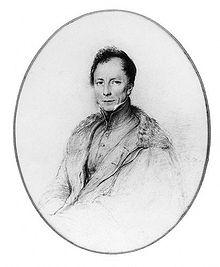Henry hangover
Henry Kater (born April 16, 1777 in Bristol , † April 26, 1835 in London ) was a British physicist and astronomer, known for the development of precision instruments.
Kater's father Henry (1748–1794) was a German pastry chef who married an Englishwoman and made it prosperous in Bristol. Kater first wanted to study law and did an apprenticeship with a lawyer, but after his father's death in 1794 he joined the army in India, where he helped William Lambton in Madras with the large trigonometric survey of the country. He also devoted himself to mathematical studies and published about it. In 1799 he joined the 12th foot regiment in Madras and became a lieutenant in 1803. For health reasons, he returned to England in 1808 and went to the Senior Department of the Royal Military College in Sandhurst and then to the second battalion of his regiment in Jersey. He was promoted to captain, but resigned in 1814 with half payment and devoted himself to scientific research. He lived in London. After the death of his mathematically gifted daughter Agnes (1811-1827) and his wife in 1833, he increasingly withdrew.
He dealt with the development of instruments, such as in 1817 a reversion pendulum named after him for measuring gravity ( gravimeter ), which became a standard instrument for geodesists. In 1825 he invented a collimator (floating collimator) for determining the horizon position in astronomy and he was also one of the inventors of the prism compass. He published comparative studies on the Cassegrain telescope and Gregory telescope (with advantages for the Cassegrain telescope), on compass needles and on British length and mass standards and Russian length standards (for which he received the Russian Order of St. Anne in 1814 ). He was also a member of the Royal Commission on Standards. In astronomy he published about Saturn's rings and length determination from lunar eclipses. He wrote a book on mechanics (in the Cabinet Cyclopedia by Dionysius Lardner ).
In 1815 he became a Fellow of the Royal Society , whose Copley Medal he received in 1817 and whose treasurer he was for several years, in 1819 a corresponding member of the Académie des Sciences and in 1826 a foreign member of the Swedish Academy of Sciences . In 1831 he received the gold medal from the Royal Astronomical Society . In 1832 he was elected to the American Academy of Arts and Sciences . In 1820 he gave the Bakerian Lecture on the best material and shape of compass needles.
He was friends with John Herschel .
He had been married to Mary Frances Reeve (from a wealthy landowning family who owned in Mexborough, South Yorkshire) since 1810 and had three children.
After Henry Kater's death, his son Edward (1816–1866) published his essay on the regulator of an astronomical clock. A large part of Henry Kater's estate came to Australia (Sydney Observatory and Sydney University) through his son Henry Herman Kater (1813–1881).
Cape Kater and indirectly also the Kater rocks are named after Kater in the Antarctic .
Web links
- Biography, English ( page no longer available )
- Publications by H. Kater in the Astrophysics Data System
- NN: Captain Henry Hangover. Monthly Notices of the Royal Astronomical Society, Vol. 3 (1836), p. 155. (Obituary, English)
Individual evidence
- ^ List of members since 1666: letter K. Académie des sciences, accessed on January 6, 2020 (French).
| personal data | |
|---|---|
| SURNAME | Hangover, Henry |
| BRIEF DESCRIPTION | British physicist |
| DATE OF BIRTH | April 16, 1777 |
| PLACE OF BIRTH | Bristol |
| DATE OF DEATH | April 26, 1835 |
| Place of death | London |
